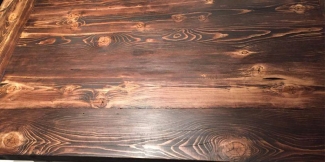

While Gel Stain can be applied over an existing finish, it was originally engineered for raw wood surfaces. We prefer applying the Gel Stain over a slip coat of mineral spirits instead of topcoat as shown in this video, "How to Apply Gel Stain to Raw Wood"
General Finishes offers a complete line of oil based, water based and wax products. Application techniques differ between oil based products and water based products.

Pine is full of pitch (rosin or tar) and stain alone will never adhere to these areas. The knots are so dense and hard there is no grain to hold the stain in place
To fix, sand the table lightly with 120-grit sandpaper and restain the table. To improve adherence of the stain, mix 2 parts Gel Stain with one part Gel Satin Topcoat. Apply as many coats of the mix as needed to obtain the desired color, allowing 24-hour dry time between coats.
All bright white paint will yellow slightly with time, even without topcoat. You have probably tried to touch up white woodwork in your home after several years and noticed that the new paint is brighter.
But white and light paints can react if clear coated with a waterbased finish; water-based topcoats are reactive and may draw out substances in the wood such as tannins, dyes or unknown substances in existing finishes causing the topcoat to yellow. This is an industry-wide issue and can happen right away, years later or never.
Our recommendation to fix white cabinets that have yellowed is to do a thorough sanding and precleaning and recoat with the following products:
It's a wrap! General Finishes next round of tutorial videos are on their way! We will be releasing one per week for the month of November so stay tuned.
It is normal to see a bit of stain on the brush when applying the first coat of topcoat. Topcoats often pull a bit of color on the first pass, but good preparation will minimize this.
To prepare open grains woods such as raw Oak for a water-based stain, we recommend sanding with 180-grit followed by no more than 220-grit sandpaper.
Haze (the technical term is blush) is caused by too many coats applied too quickly. A recoat time of 12 hours is not enough dry time when applying over an EXISTING finish. To remove the blush or haze, you can either wipe the area with a strong solvent, like xylene or lacquer thinner, or you can try sanding out the haze and then reapply the topcoat.